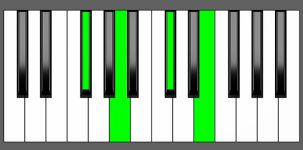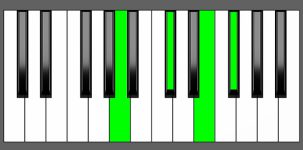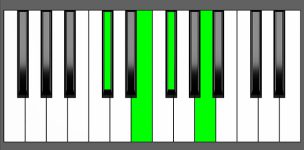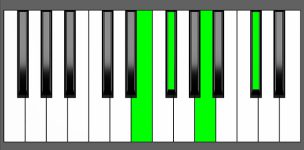Piano Diagram of Gbm7 in Root Position
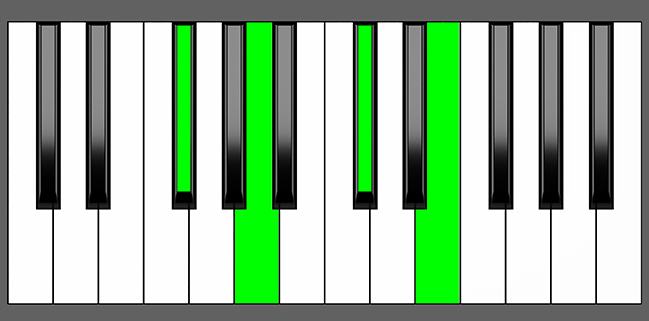
Gbm7 is a minor chord built on the key of Gb with an added minor 7th. It is formed by the notes Gb, Bbb, Db, and Fb. In this article, we’ll explore the music theory underlying the Gbm7 chord, including its construction, common voicings, and its role in chord progressions.
Structure of Gbm7
Notes |
|---|
| Gb, Bbb, Db, Fb |
Intervals |
|---|
| R, m3, 5, m7 |
Finger Position
Left Hand |
|---|
| 5, 3, 2, 1
5, 4, 2, 1 |
Right Hand |
|---|
| 1, 2, 4, 5
1, 2, 3, 4 |
Gbm7 Chord Inversions
The Gbm7 chord has a total of 3 inversions:
| Root Position: | Gb | Bbb | Db | Fb |
| 1st Inversion: | Bbb | Db | Fb | Gb |
| 2nd Inversion: | Db | Fb | Gb | Bbb |
| 3rd Inversion: | Fb | Gb | Bbb | Db |
Piano Keyboard Diagrams
Gbm7 Chord Equivalencies
Rearranging the notes of a chord can result in unique and interesting chord equivalencies. This is particularly true for 7th chords, where we can create a distinct type of chord by rearranging the notes of a minor 7th chord in a specific way.
For instance, if we take the 1st inversion of a minor 7th chord, where the 3rd note becomes the root note, we end up with a major 6th chord (also known as an “add 6th” chord).
Let’s consider the Gbm7 chord, which comprises the notes Gb, Bbb, Db, and Fb. If we rearrange the notes such that A becomes the root note, we obtain an A6 chord with the notes Bbb, Db, E, and Gb.
1st Inversion of Gbm7 = A6
The reason why the 1st inversion of a minor 7th chord results in a major 6th chord is due to the note relationships between the chords. When we move the 3rd note to become the root note, we end up with a chord that features a major 3rd, perfect 5th, and a major 6th interval.
Music Theory and Harmony of Gbm7
In music theory, m7 chords, also known as minor seventh chords, are commonly used and have a melancholic or introspective quality. They can be found in various genres such as jazz, blues, pop, and classical music. These chords add richness and tension to a musical piece and are often used as tonic, subdominant, or dominant chords.
Building the Gbm7 Chord: Different Approaches
When building a minor seventh (m7) chord, there are a few different approaches you can take. These approaches can be used interchangeably to construct m7 chords and provide different perspectives on building these chords:
Starting from the Gb Major Scale
Gb minor 7th is built by combining the Root, a minor 3rd, a 5th, and a minor 7th interval from a minor scale, however, for educational purposes, it may be clearer to demonstrate its construction using a major scale, as it better illustrates the relationship between intervals and their qualities.
For example, to build a Gbm7 chord, you can start with the Gb Major scale, which consists of the notes Gb, Ab, Bb, Cb, Db, Eb, and F.


To create a Gbm7 chord, apply the formula R, m3, 5, m7 in the following manner:
- Begin with the Root note, Gb.
- Select the 3rd interval, which is Bb then lower it down by a half-step to get the minor 3rd A which we’ll call Bbb (B double flat) to preserve the basic chord structure.
- Include the 5th note, Db.
- Finally, add the minor 7th interval, Fb (E).
By following this simple formula, you can create a minor 7th chord from any major scale.
by Combining Intervals
Another way to form a minor 7th chord is by combining specific intervals – a minor 3rd, a major 3rd, and another minor 3rd.
m3 + 3 + m3 = minor 7th Chords
If we observe the intervals between the notes, we can notice that Gb-A (Bbb) creates a minor 3rd interval, Bbb-Db forms a major 3rd interval, and Db-E (Fb) is a minor 3rd interval. By stacking these three intervals together, we can build the Gbm7 chord.
How to Use Gb min7 in a Chord Progression
Gbm7 appears in the context of certain natural minor scales and major scales, which are often referred to as theoretical keys. These scales include uncommon key signatures that involve double-flats or double-sharps, making them less commonly used in practical musical contexts. The Gbm7 chord, therefore, is more frequently used as its enharmonic equivalent F#m7:
on Natural minor Scales
| Minor Scales | i | ii | III | iv | v | VI | VII |
|---|---|---|---|---|---|---|---|
| Gb = F# | F#m7 = Gbm7 | G#m7b5 | A Maj7 | B min7 | C# min7 | D Maj7 | E7 |
| Db = C# | C# min7 | D#m7b5 | E Maj7 | F#m7 = Gbm7 | G# min7 | A Maj7 | B7 |
| Cb = B | B min7 | C#m7b5 | D Maj7 | E min7 | F#m7 = Gbm7 | G Maj7 | A7 |
- Tonic chord in F# minor as F#m7
- Subdominant chord in C# minor as F#m7
- Dominant chord in B minor as F#m7
on Major Scales
| Major Scales | I | ii | iii | IV | V | vi | vii |
|---|---|---|---|---|---|---|---|
| Fb = E | E Maj7 | F#m7 = Gbm7 | G# min7 | A Maj7 | B7 | C# min7 | D#m7b5 |
| Ebb = D | D Maj7 | E min7 | F#m7 = Gbm7 | G Maj7 | A7 | B min7 | C#m7b5 |
| Bbb = A | A Maj7 | B min7 | C# min7 | D Maj7 | E7 | F#m7 = Gbm7 | G#m7b5 |
- Supertonic chord in E Major as F#m7
- Mediant chord in D Major as F#m7
- Submediant chord in A Major as F#m7
Gbm7 as Tonic Chord in Gb Minor
Gbm7 as Subdominant Chord in Db Minor
Gbm7 as Dominant Chord in Cb Minor
Gbm7 as Supertonic Chord in Fb Major
Gbm7 as Mediant Chord in Ebb Major
Gbm7 as Submediant Chord in Bbb Major
Alternative Names for Gbm7 Chord
- Gb-7
- Solb -7
- Solb m7
- Gbm7th
- Gb min7
- Solb min7
- Gb minor 7th
- Gb minor seventh
